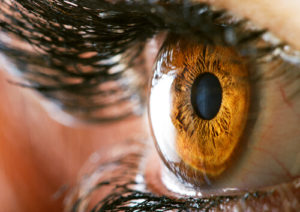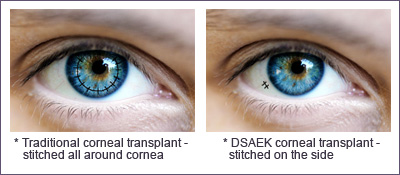 DSAEK is a corneal surgery procedure for extreme instances of cornea problems, corneal disease, or for damaged corneas.
DSAEK is a corneal surgery procedure for extreme instances of cornea problems, corneal disease, or for damaged corneas.
The cornea is the outer surface of your eye. If you are not familiar with the cornea it is a remarkable structure that helps to focus light and protect the internal structures of the eye.
The shape of the cornea is important to the focusing of light on the retina in the back of the eye. A properly shaped cornea and healthy lens will allow this light to focus clearly, providing crisp vision. It is also important that the cornea remains clear so the light can pass through to the retina without being interrupted. If the cornea gets hazy or cloudy, or if the shape of the cornea becomes irregular, vision can be impaired. Some causes of this include age, trauma, or disease. When vision is impaired enough to affect a patient’s daily functioning, it may need to be totally or partially replaced by a corneal transplant procedure.
What is DSAEK?
DSAEK is a relatively new, but well-tested corneal surgery technique that can help some patients who previously required a full thickness corneal transplant. The procedure is similar to the traditional cornea transplant because both use donor corneas to replace damaged or diseased corneas. Both the conventional corneal transplant technique and DSAEK require the use of a donor cornea, but DSAEK replaces only the damaged posterior section of your cornea. In a conventional corneal transplant surgery, the entire cornea is replaced. This procedure involves large incisions, many stitches, and a very long recovery time. In contrast, DSAEK requires minimal suturing, allows more rapid visual restoration, less discomfort, and a reduced risk of sight-threatening complications.
In DSAEK surgery, the ophthalmologist will start by making a small incision in the sclera (white tissue, of the eye). This incision gives access to the inner surface of the cornea. The diseased endothelial tissue is removed through the incision, and the donor tissue from the eye bank is implanted.

What happens in DSAEK cornea surgery?
Fuchs’ Dystrophy patients are the primary group of patients needing a DSAEK procedure. Fuchs’ endothelial dystrophy (FED) is a degenerative disorder of the corneal endothelium leading to corneal edema and loss of vision. Patients first receive a full evaluation so that our doctors can best determine the patient’s treatment options, including the need for DSAEK surgery.
On the day of surgery, the patient will arrive at the surgery center approximately one hour prior to surgery for preparation. The patient must not eat anything after midnight the day before surgery and will begin pre-operative medications three days prior to surgery as instructed. Prior to the patient’s surgery, the surgeon will prepare for surgery by determining the type of tissue to be used and selecting the technique needed to ensure the best surgical outcomes possible. After the (approximately) one-hour surgery, the patient must lie flat on their back so air can push up into the cornea and hold the new tissue in position. Once the tissue sticks to the cornea, it will begin to function and pump the water out of the cornea, clearing vision. Vision improves fairly rapidly, with final visual results obtained in approximately one to six months after surgery.
If you are familiar with Fuchs Dystrophy and you are a patient who requires immediate attention, our DSAEK specialists might be able to help you. In order to start the process of understanding your candidacy for this procedure, we will need you to schedule an appointment so that we can examine your eyes.






